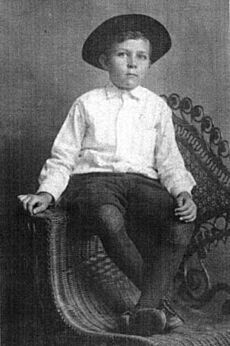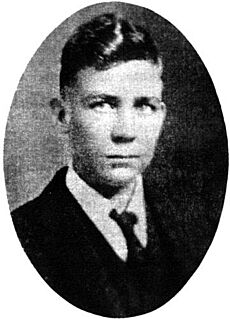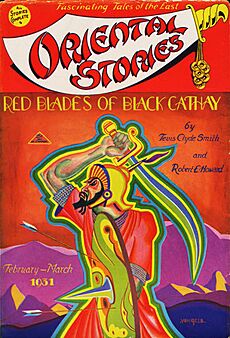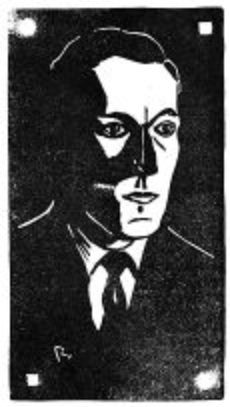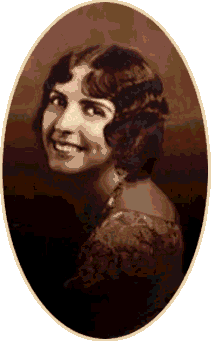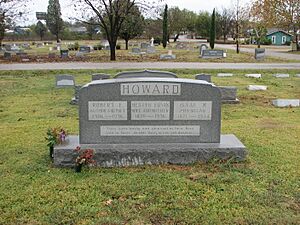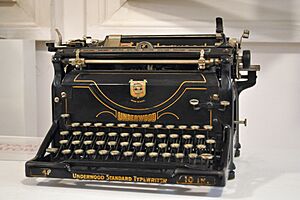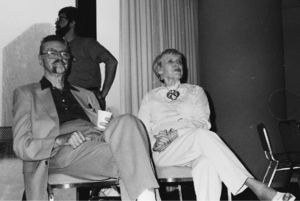Robert E. Howard facts for kids
Quick facts for kids
Robert E. Howard
|
|
|---|---|
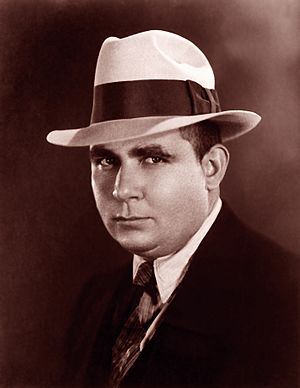
Howard in 1934
|
|
| Born | Robert Ervin Howard January 22, 1906 Peaster, Texas, U.S. |
| Died | June 11, 1936 (aged 30) Cross Plains, Texas, U.S. |
| Pen name | Patrick Mac Conaire, Steve Costigan, Patrick Ervin, Patrick Howard, Sam Walser |
| Nickname | REH, Two-Gun Bob |
| Occupation |
|
| Genre | Sword and sorcery, westerns, boxing stories, historical, horror, southern gothic |
| Literary movement | Sword and sorcery, weird fiction |
| Notable works | Conan the Cimmerian (series), Solomon Kane (series), Bran Mak Morn, King Kull, El Borak, The Shadow of the Vulture |
| Signature | |
|
|
|
Robert Ervin Howard (born January 22, 1906 – died June 11, 1936) was an American writer. He wrote many different kinds of stories for magazines. He created the famous character Conan the Barbarian. He is also known as the "father" of the sword and sorcery style of fantasy stories.
Howard grew up in Texas. He lived most of his life in Cross Plains. As a child, he loved books and learning. He also enjoyed boxing and bodybuilding. From age nine, he dreamed of being an adventure writer. He became successful at age 23. He wrote many stories until he died at 30. His most famous works became popular after his death.
Howard's stories were not put into books during his lifetime. His main place for publishing was Weird Tales magazine. There, he created Conan the Barbarian. With Conan and his other heroes, Howard helped create the "sword and sorcery" genre. This style inspired many other writers. Howard is still a very popular author today. His best stories are still printed. He is one of the best-selling fantasy writers ever.
Contents
Biography
Early life and influences
Robert E. Howard was born on January 22, 1906, in Peaster, Texas. He was the only child of Dr. Isaac Mordecai Howard and Hester Jane Ervin Howard. His family moved often when he was young. They lived in many Texas towns like Seminole and Wichita Falls.
Howard's mother loved poetry and books. She encouraged him to read and write. This helped him develop a deep love for literature. He also learned the importance of being strong. He saw how bullies acted and learned that physical strength could be helpful.
As a doctor's son, Howard often saw injuries and violence. This was common in oil boomtowns. He became very interested in sports, especially boxing. Boxing was a very popular sport back then. Famous boxers like Jack Johnson inspired him.
Becoming a writer
Howard loved to read and had a natural talent for writing. Teachers also encouraged him. He started writing stories at age nine. Most were historical tales about Vikings and battles. He was influenced by authors like Jack London and Rudyard Kipling. Howard had a great memory. He could easily remember long poems after reading them just once or twice.

In 1919, when Howard was 13, his family moved to Cross Plains. They stayed there for the rest of his life. In 1920, oil was found in Cross Plains. The town grew very fast. Thousands of people came looking for oil wealth. New businesses opened, but crime also increased. Howard did not like the changes the oil boom brought.
At 15, Howard discovered pulp magazines. These were cheap magazines with exciting stories. He loved Adventure magazine. He started writing his own stories and sending them to magazines. He got many rejections at first. He taught himself how to write better by studying what magazines wanted.
In 1922, Howard moved to Brownwood for his last year of high school. There, he met friends who also loved sports, history, and writing. Tevis Clyde Smith and Truett Vinson were important friends. They wrote amateur magazines together. Howard's first stories were printed in the Brownwood High School newspaper, The Tattler.
After graduating in 1923, Howard returned to Cross Plains. He started a strict exercise routine. He chopped wood, lifted weights, and boxed. He changed from a skinny teenager to a strong, muscular person.
Professional career
Howard worked odd jobs in Cross Plains, but he disliked them. In 1924, he went back to Brownwood to study stenography (shorthand). He would have preferred to study literature.
In November 1924, he finally sold his first story, "Spear and Fang." It was a caveman tale. It was published in Weird Tales magazine in July 1925. He earned $16 for it. This was the start of his writing career.
Howard then left college and returned to Cross Plains. He tried writing a novel, but it was not published until after his death. He also wrote for the local newspaper to earn money. He tried other jobs but often quit because he disliked them.
He also wrote many poems. Dozens were published in Weird Tales and other journals. But poetry did not pay well. After 1930, he focused on short stories. His stories became more like "prose-poems," with vivid descriptions.
Howard became a regular writer for Weird Tales. His first cover story was "Wolfshead" (a werewolf story). He was only 20. He later quit his job to focus on writing.
Sword and sorcery stories
In August 1926, Howard started writing "The Shadow Kingdom." This became a very important story. It mixed fantasy, horror, and history with action and swordplay. This new style became known as "sword and sorcery." The story featured Kull, a barbarian king. It was published in Weird Tales in August 1929. The editor bought it for $100, which was a lot for Howard then.
In 1928, Howard created Solomon Kane, a vengeful Puritan adventurer. The first story, "Red Shadows," was published in August 1928. Solomon Kane became Howard's first character to have a long series of stories. This story is considered the first published example of sword and sorcery.
Howard started selling stories to other magazines in 1929. He had success with boxing stories. In July 1929, Sailor Steve Costigan appeared in Fight Stories. Costigan was a tough sailor who boxed in exotic places. This series became very popular. It provided Howard with a steady income.
By 1931, Howard was a full-time writer. He was making good money. His father was proud of his success. Howard also became interested in his Irish heritage. He created characters like Turlogh Dubh O'Brien and Cormac Mac Art.
When Oriental Stories magazine started in 1930, Howard was excited. He wrote many tales about war and magic in the Middle and Far East. These stories were some of his best.
The Lovecraft Circle
In 1930, Howard started writing letters to H. P. Lovecraft, another famous Weird Tales writer. They became good friends. Howard joined the "Lovecraft Circle." This was a group of writers who shared ideas and helped each other.
Howard was nicknamed "Two-Gun Bob" because he wrote so much about the Southwest. He also added elements to Lovecraft's Cthulhu Mythos horror stories. He discussed ideas about "barbarism versus civilization" with Lovecraft. Howard believed civilization was weak and would always fall to barbarism.
In 1930, Howard returned to his love for the Picts. He wrote stories like "Kings of the Night" and "Worms of the Earth." These stories featured Bran Mak Morn, a Pictish king.
The Great Depression made it hard for many magazines. Some closed down. Howard also lost his savings when banks failed.
Conan the Barbarian
In early 1932, Howard traveled through Texas. In Fredericksburg, he imagined the land of Cimmeria. This was a harsh northern region where fierce barbarians lived. In February, he wrote the poem Cimmeria.
It was during this trip that Howard first thought of Conan. He developed the idea over nine months. He created a whole new world called the Hyborian Age. It had many countries, people, monsters, and magic. This allowed him to write exciting historical fantasy without needing to do endless research.
By March, Howard had rewritten an old story into his first Conan tale. It was called "The Phoenix on the Sword." He quickly wrote two more Conan stories. He sent them to Weird Tales. The editor liked them and asked for changes. Howard kept working on Conan.
Conan first appeared in Weird Tales in December 1932. He was an instant hit. Howard wrote 17 Conan stories for the magazine between 1933 and 1936. Some of these stories were simpler, but they sold well.
In 1933, a British publisher wanted to publish a book by Howard. Howard sent some of his best stories. The publisher suggested a novel instead. Howard then wrote his only Conan novel, The Hour of the Dragon. He worked very hard on it. However, the publisher went out of business before printing it. The novel was later printed in Weird Tales as a series.
Howard started to lose interest in Conan in late 1934. He wanted to write westerns. He wrote "Wolves Beyond the Border," which was the first Conan story where Conan himself does not appear. He also wrote "Beyond the Black River," where the heroes only get a small victory. This was unusual for pulp stories.
Conan became very influential. Many other writers were inspired by him. The "sword and sorcery" genre grew around Howard's creation.
New types of stories
In 1933, Howard hired an agent, Otis Adelbert Kline. Kline encouraged him to write in other genres. This helped Howard sell stories to more magazines.
Howard wrote one of the first "Weird Western" stories, "The Horror from the Mound." This mixed horror with western themes. He also tried writing detective stories, but he disliked them.
In late 1933, Howard created El Borak. This character was a grim gun-fighter in the Middle East during World War I. These stories were very successful. He also created Kirby O'Donnell, a similar character.
Howard became very interested in the history and lore of Texas. His Conan stories started to include western elements. By 1934, some magazines that had closed during the Depression reopened. Howard stopped writing "weird fiction" and focused on westerns.
His most successful series during his lifetime started in 1933. These were the Breckinridge Elkins stories. They were funny westerns, like his earlier Steve Costigan stories. Elkins was an exaggerated version of Howard himself. These stories were very popular.
Conan was the only character Howard talked about with his friends. It seems his western characters were too personal for him to discuss.
Novalyne Price
Howard had one known girlfriend, Novalyne Price. She was a friend of his best friend, Tevis Clyde Smith. They met in 1933. Price was also an aspiring writer. She was surprised by Howard's appearance, as he didn't look like she expected a writer to look.
They started dating in late 1934. They spent a lot of time talking about writing, philosophy, and history. They considered marriage, but never at the same time. Their relationship ended in 1936.
Price kept a journal of their conversations. This helped her write a book about their relationship called One Who Walked Alone. This book was later made into a movie, The Whole Wide World (1996).
Death
By 1936, Howard was mostly writing westerns. His novel A Gent from Bear Creek was going to be published in England. It seemed he was finally moving from magazines to books.
However, life was difficult for Howard. His friends were getting married. Novalyne Price had left town. Weird Tales owed him a lot of money. His mother was also very ill. The stress made it hard for him to write.
Robert E. Howard died on June 11, 1936. His mother died the next day. They had a joint funeral and were buried in Greenleaf Cemetery in Brownwood, Texas.
Character and personality
Views and beliefs
Howard's views on race are often discussed. He sometimes used racial stereotypes in his stories. However, his views changed over time. Later stories showed more understanding towards different groups.
Howard also had views that supported women's rights. This was unusual for his time and place. He wrote to his friends defending women's abilities. His stories featured strong female characters. These included Dark Agnes de Chastillon, the pirate Helen Tavrel, and Conan's companions Bêlit and Valeria.
Physical appearance and hobbies
Howard was tall and strongly built. He had a kind, round face and a soft, deep voice. One friend described him as "powerful, solid, round-faced."
Howard loved listening to stories. He grew up in Texas, where telling "tall tales" was common. He was also a natural storyteller himself. This sometimes meant he would make facts more exciting for a better story.
He had an amazing memory. He could remember long poems after only a few readings. He also enjoyed listening to music and drama on the radio. His main interests were sports and politics.
After he bought a car in 1932, he often took trips with friends across Texas. He also loved boxing and weightlifting.
Writing style and influence
Howard's first published poem was The Sea in 1923. His first published story was "Spear and Fang" in 1925. But his first big success was the Sailor Steve Costigan boxing stories, starting in 1929.
Style and themes
Howard's writing style is unique. It combines deep thoughts, poetic language, violence, and humor. His Texas background influenced the rhythm of his stories. He used few words to create vivid scenes. His stories, especially Conan's, are often dark and gritty.
The oil booms in Texas greatly influenced Howard. He disliked the oil industry. He saw how progress could bring crime and corruption. A common theme in his writing is that civilizations rise, become weak, and then fall. Many of his stories are set in times of decay or among old ruins.
Influences and impact
Howard was influenced by the pulp magazine Adventure. He tried many times to sell stories to this magazine, but never did.
He also influenced his friend H. P. Lovecraft. They discussed many ideas in their letters. Lovecraft even started adding more action to his own stories because of Howard.
Howard was also inspired by Theosophy. This belief system included ideas about lost civilizations and ancient magic.
Howard has inspired many later writers. These include David Gemmell and Michael Moorcock. He is one of the most important fantasy writers, alongside J. R. R. Tolkien.
Earnings
Howard's earnings from writing grew over his career. During the Great Depression, he earned more than anyone else in Cross Plains. When he died, Weird Tales still owed him money.
| Year | Earnings | Notes |
|---|---|---|
| 1926 | $50.00 | |
| 1927 | $37.50 | |
| 1928 | $186.00 | First Solomon Kane story published |
| 1929 | $772.50 | First Kull and Steve Costigan stories |
| 1930 | $1,303.50 | Oriental Stories magazine started |
| 1931 | $1,500.26 | |
| 1932 | $1,067.50 | First Conan story |
| 1933 | $962.25 | |
| 1934 | $1,853.05 | First El Borak and Breckinridge Elkins stories |
| 1935 | $2,000+ | Records are not complete for this year |
| 1936 | "By the spring of 1936, he was selling more than ever before." | |
Legacy
Robert E. Howard's influence continued long after his death. His most famous character, Conan the Barbarian, is as well-known as Tarzan of the Apes or Sherlock Holmes.
After Howard died, his father managed his writings. The rights to his works were passed down through his family. Eventually, a company called Paradox Entertainment bought the rights.
Howard's first novel, A Gent from Bear Creek, was printed in Britain in 1937. His first Conan novel, Conan the Conqueror, was published in 1950. The success of Conan the Conqueror led to many more Conan books.
In 1966, the Conan series was republished. This led to a big increase in Howard's popularity in the 1970s. The amazing cover art by Frank Frazetta helped a lot. Many of Howard's stories were reprinted. His works also expanded into comic books and movies.
Later, fans wanted to read Howard's original, unedited stories. In the late 1990s and early 2000s, there was another "Howard Boom." New collections of his original works were printed. This also led to new comic books, films, and computer games.
Howard's house in Cross Plains is now the Robert E. Howard Museum. It is a recognized historical place.
Adaptations
Robert E. Howard's stories have been made into many different forms of media.
- Movies: There have been two Conan films starring Arnold Schwarzenegger in the 1980s. Another Conan movie came out in 2011 with Jason Momoa. Other movies include Kull the Conqueror (1997) and Solomon Kane (2009).
- Television: The TV show Thriller (1961) had an episode based on Howard's story "Pigeons from Hell." Most TV adaptations have been about Conan, including animated and live-action series.
- Audio: Many of his works have been adapted into audio books and plays.
- Video Games: Computer games have focused on Conan, like Conan: Hall of Volta (1984) and Age of Conan: Hyborian Adventures (2008).
- Tabletop Games: The first roleplaying game based on Howard's works was "Conan Unchained!" (1984) for Advanced Dungeons & Dragons.
- Comic Books: The first comic book adaptation was in Mexico in 1952. Howard-related comic books are still published today.
Howard has also inspired heavy metal music. Some bands have named themselves after his stories or written songs about his works. The British band Bal-Sagoth is named after Howard's story "The Gods of Bal-Sagoth."
See also
 In Spanish: Robert E. Howard para niños
In Spanish: Robert E. Howard para niños
- List of horror fiction writers
- List of people from Texas
- List of poets from the United States
- Reptilian conspiracy theory – Robert E. Howard's story "The Shadow Kingdom" helped create the sword and sorcery subgenre of fantasy fiction. It also influenced the conspiracy theory about hidden reptilian beings secretly controlling the world.


